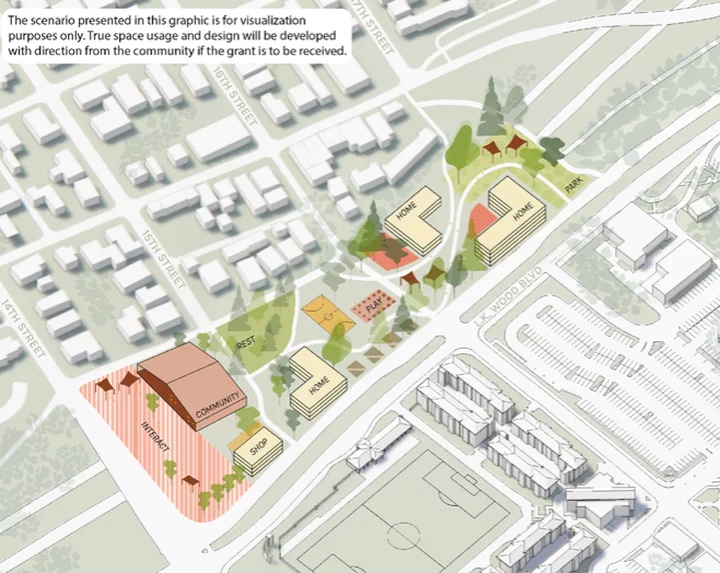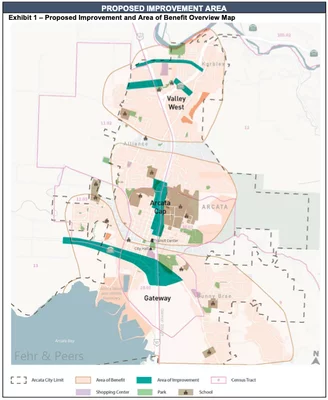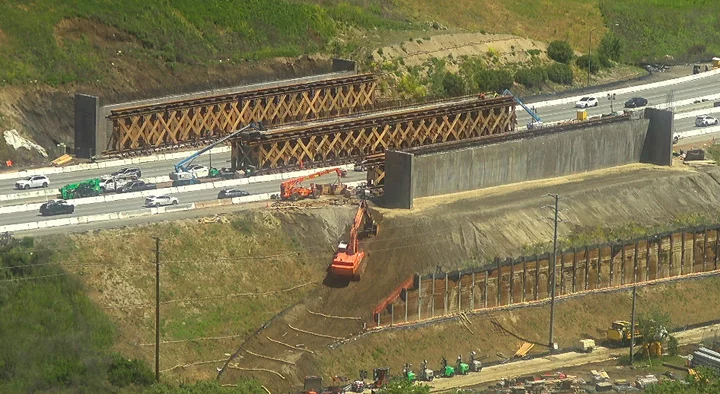The potential vision for the Arcata Cap, which could create space for more housing, and places to shop, rest or play. | Image from Arcata’s grant application packet
###
It’s pretty much common knowledge at this point that Arcata (along with many other cities) is making a mad dash to plan for the creation of a lot more housing, both because it is badly needed and because it is required by the state. But one of the biggest roadblocks municipalities like Arcata face is that there is not a lot of undeveloped land left for building that housing. Arcata has been navigating this issue through promoting infill development, creating documents like the Gateway Area Plan, which aims to allow for housing to be built on all kinds of small or already partially developed sites that may not have been previously earmarked for development.
Now the City of Arcata is exploring another widely available space for development– the air. More specifically, the air above Highway 101.
That’s right. The City of Arcata is in the process of planning a project that would build entirely new land suspended above 101 between 14th and 17th Streets, connecting Northtown to LK Wood Boulevard. The project is known as the Arcata Cap – which would create about five acres of additional land that could be used to build housing and other community resources, while also providing a bike-and-pedestrian-friendly connection between the east and west segments of the city that are divided by Highway 101.
“The cap makes perfect sense in this area for various reasons,” Netra Khatri, Arcata’s city engineer, told the Outpost in a recent phone interview. “The area between 11th and 17th Street, if you drive through the highway, you will see that the highway is low and the grounds on either side are higher…Around it there’s a lot of dead zone – an area that’s not generally used right now. And once you put a flat area on it you will be able to use that for various things. It could be housing, it could become a community park, it could be a transit hub, anything you want.”
Sound insane? It might be. But, impossible? Well, city and state government agencies certainly don’t think so. In fact, this plan just became part of the California Department of Transportation (CalTrans) project Reconnecting Communities: Highways to Boulevards – a pilot program created after the the adoption of Streets & Highways Code 104.3 that funds the conversion of underutilized highways into multimodal corridors. And the City of Arcata was selected to receive a big ol’ chunk of grant funding to realize this literally lofty goal.
Khatri said that the exact amount of money Arcata will receive for this project is still unknown, but that Arcata was among three communities selected to receive the funding, along with San Diego and San Francisco. Khatri said that Caltrans has made $148 million available in grant funding, which will be divided (not necessarily equally) between the three awardees.
And though $148 million is a hefty sum, it will not get any of these projects anywhere near completion. As you can probably imagine, building acres of new land on top of a highway will be an extremely expensive and involved project that will take years and probably hundreds of millions of dollars to complete. Khatri said that the money Arcata receives will go toward the planning phase, including conducting studies, community outreach and drafting the plan. Any remaining funds will be used to leverage additional funding in the future for implementation of the project.
Arcata’s vision for this project includes more than just the proposed highway cap. The idea, Khatri said, is to “reconnect Arcata” in the areas that have been separated by the highways, and the project also proposes improvements to Samoa Boulevard and the Valley West neighborhood. Khatri said that it is still not completely clear what those improvements would look like, but would likely include adding additional highway crossings, either building new bridges or improving existing bridges to be more friendly to bicyclists and pedestrians.
The idea, for Arcata’s project and the other projects Caltrans is funding, is that if we build more places for people to walk and bike across the highway that they will do so, and that would help further lots of California’s goals – decreasing greenhouse gasses by discouraging driving cars and improving public health by encouraging biking and walking.
“Our city is divided by 101 exactly in half,” Khatri said. “We used to have 17 or 18 connections – streets connecting the east and west. Right now we have only five connections. Those are all bridges and some of them don’t even have proper bike lanes and sidewalks.”
And it is true that some of the places where you can cross the highway are pretty dicey for cyclists and pedestrians. There is only one dedicated pedestrian bridge, which crosses over the highway at 17th Street and connects to Cal Poly Humboldt campus. The bridge that crosses on Samoa Boulevard (Highway 255) has no sidewalk or bike lanes, and although that certainly does not stop many people from crossing on bike or by foot, it can be pretty scary. If someone prefers not to risk it, they currently have to make their way up to Seventh street for another option to cross 101.
But if increasing people’s ability to cross Highway 101 is the big issue, why not just focus on improving the existing bridges and maybe adding a couple more? That seems like it would be a much more feasible solution than this highway cap idea. But Khatri said it’s about more than just improving accessibility between the different sections of Arcata, it’s also about improving our environmental ecology by creating more green space on the highway cap and “reconnecting the forest to the bay.”
“At one point this was forested land and because of the industrial revolution or other aspects of human nature, we went into development and we – I wouldn’t say the word destroy, but that’s the first thing that comes to my mind – have destroyed the forest, the creek. Jolly Giant Creek at some point was an open creek but right now it’s covered by downtown.”
By creating a highway cap, the hope is that it can help the city’s return to a simpler time, before the community was torn in half by four lanes of asphalt, when humans and other living things could freely roam across the land.
Current construction on the Wallis Annenberg Wildlife Crossing. | Screenshot from online web cam.
The idea is not totally new or unique to our region and many other communities are planning, or having even begun constructing highway caps – also referred to as highway lids or land bridges – as a way of returning the highways to the land without actually removing the road. One example is the Wallis Annenberg Wildlife Crossing, which is currently under construction in Agoura Hills and will cover a portion of Highway 101 to provide a place for wildlife to safely cross. Up in Portland, Ore. the I-5 Rose Quarter Improvement Project just clinched a $450 million grant to build a highway cap over the I-5 freeway to reconnect the Albina neighborhood to the city’s downtown. Another similar and already completed project is the Presidio Tunnel Tops in San Francisco, where portions of the Presidio Parkway run underground, with the park sitting atop.
Again, Arcata’s project is still in the very early planning stages. As for Arcata’s next steps, Khatri said that the City of Arcata will be working with Caltrans to form community partnerships and will be working with Cal Poly Humboldt, Humboldt County Association of Governments (HCAOG), Arcata House Partnership, the Wiyot Tribe and more to draft a plan that would provide the most community benefits. The City will also be seeking community feedback and Khatri said that staff will announce opportunities for public input over the next year or so.
Since this is a pilot program, Khatri said, all the involved agencies are still figuring out the best way to roll out the projects and allocate the funding. It will likely be at least five years before we see any actual development on the project. But Khatri is confident that it will happen and said that, even though he was very skeptical about the idea at first, the new availability of funding and the launch of other highway cap projects has made him much more confident.
“Very frankly, like five years ago when I first heard about this, I was like, ‘Well, this is impossible. The cost is going to be in the hundreds of millions and we will never get that much,’” Khatri said. “But you know, five years ago, we were applying for grants in the amount of two, three, four million. But now we are applying for grants for like $20 million.”



CLICK TO MANAGE